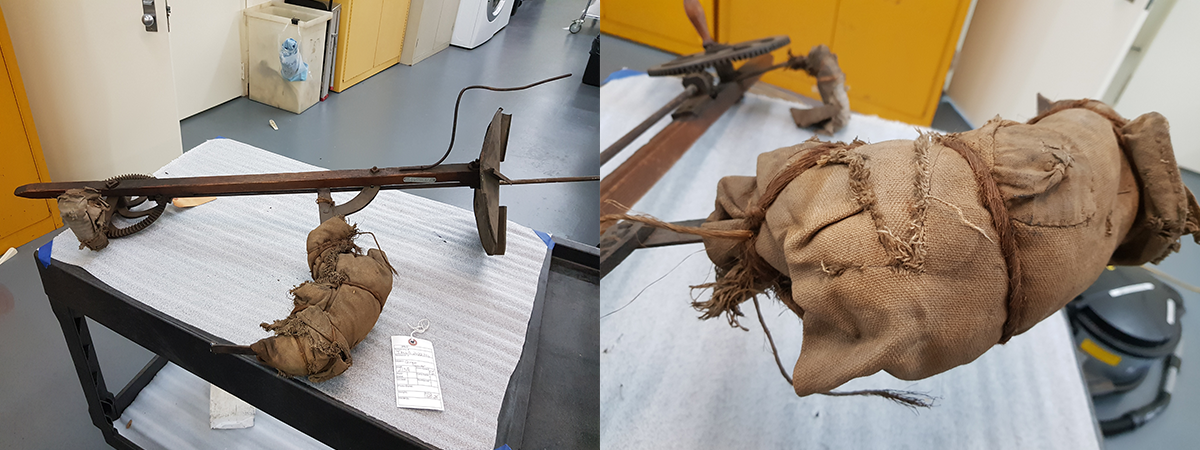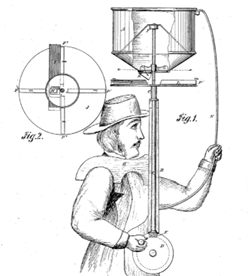J.Edison Grain Sack: 2024 IMLS Conservation Feature
A team of staff from five departments at The Henry Ford have been busy during the final three weeks of an exciting IMLS grant project. Over the last two years of this grant-funded project (October 2022-August 2024), the efforts of conservation, collections management, cataloging, the photography studio, and curatorial, have led to the treatment and interpretation of 2,106 items stored in THF’s Collections Storage Building. Read on to explore behind-the-scenes work in the conservation lab!

Broadcast Seeder with parts wrapped in fabric / Reference Images by Jeeeun Sims (Jee Eun Lim) / 00.1384.23
This object might make you scratch your head, but it held clues that curators and cataloguers explored as conservators completed their work.
Conservation of the object started with a thoughtful study to determine next steps for treatment. This required unwrapping fabric and straw bound around two of the metal components. This was likely done by the donor to protect people from injuring themselves on the sharp metal while handling the object.

Grain Sack / Reference Images by Jeeeun Sims (Jee Eun Lim) / 00.1384.23
One of the fabrics was a grain sack with the word “J.EDISION” stenciled in orange paint on the outside, front and back. The sack included torn areas that had previously been mended.
The level of dirtiness was first checked with wet paper and deionized water. Next, the bag was vacuumed to remove residual substances such as large pieces of dust and insect carcasses. During this process, we found a few grain seeds that were placed separately in a plastic bag for future research.

Grain Sack / Reference Images by Jeeeun Sims (Jee Eun Lim) / 00.1384.23
After vacuuming, conservators worked with textile Conservation Specialist Katrina Herron to perform a wet cleaning. The bag was submerged in a tray filled with tap water. The bag was lightly agitated to remove dust and contaminants. The water was replaced and the process repeated until the water was clear enough to call the bag “clean.” While changing the water, the bag was rolled with a mesh sheet and set aside. This technique reduces the likelihood of damage to the bag when carried flat, as the weight of the water can cause too much tension to the fibers.

Grain Sack Treatment / Reference Images by Jeeeun Sims (Jee Eun Lim) / 00.1384.23
The water was changed a total of fourteen times. At the beginning of the process, the dust and contaminants were removed with only tap water. The next cycles used tap water mixed with liquid soap. Orvus and Vulpex are gentle cleaners used by our conservation staff. In this project, they were used to clean the stains on the surface of the bag by pressing it with a soft sponge. In the end, deionized water was used to rinse out the soap thoroughly. Each time the water was replaced, a sample of the water was taken to determine the level of contamination.

Grain Sack before, during, and after treatment / Reference Images by Jeeeun Sims (Jee Eun Lim) / 00.1384.23
After completing the wet cleaning process, the bag was left to air dry slowly on a mesh drying rack sandwiched between clean towels. The surface of the fabric is brighter after cleaning but still retains some stains that show its previous use.
As conservators treated the object, other members of the IMLS grant team explored additional clues to help with identification.
An attached tag reads: "GRAIN SOWER"/ "FROM: MR. + MRS. HAROLD EDISON"/ "GRAND RAPIDS." The description “Grain Sower” indicates that a farmer used the machine to sow wheat or other grains. Cranking the wooden handle turned a shaft topped with a flanged disc that broadcast the seed onto the field. An inscription on one of the cast metal components gave a patent date of March 22, 1870, and that led to U.S. Patent 101,136 for a “Broadcast Seeder.” The inventor, Jacob C. Kurtz of Wooster, Ohio, included illustrations with his patent, explaining that his device could rapidly and evenly distribute seed, and could also be adapted for use from a wagon.

Illustration from U.S. Patent 101,136, issued March 22, 1870 to J. C. Kurtz, Wooster, Ohio / United States Patent and Trademark Office
J.EDISON, UNPACKED
How did Mr. and Mrs. Harold O. Edison acquire this machine? The donors, likely Mr. Harold Ogden Edison and his wife Cosetta A. Hessey, did not explain this history, but the grain sack with “J.Edison” stenciled on it provided a critical clue. Harold descended from the family of Moses Edison (1783-1849). Moses had a son, John, who likely purchased the broadcast seeder and had the grain sack stenciled “J.Edison.”
In 1837, Moses, his wife Jane Saxton (1787-1872), and several children including John (1806-1889) moved from Vienna, Canada, to Walker Township, Kent County, Michigan (the Grand Rapids area). This date derives from a reminiscence shared when the Moses Edison family donated their spinning wheel to The Henry Ford (Wool Wheel, C. 1800-1830 / THF176591). They settled on land north of the Grand River, which was previously occupied by Ottawa (Odawa), Chippewa (Ojibwa), and Potawatomi (Bodewadi) peoples, who were required as part of the 1833 Treaty of Chicago to move to Kansas territory.
Did the Edison families in Walker Township have any connection to Thomas Alva Edison? Yes.
Moses was a brother of Samuel Ogden Edison (1767-1865) who was Thomas Alva Edison’s grandfather—which meant that Moses was Thomas Edison’s great uncle, and John (the owner of the grain sack) Edison’s first cousin once removed. In 1933, Thomas Edison’s homestead was sold to Henry Ford and moved to Greenfield Village. The broadcast seeder treated during the IMLS grant was located in the Edison Homestead as of 1951, confirmed by a small aluminum plate attached to its base (E.H.-382) during an inventory conducted in the house that year.
Thanks to funding from the Institute of Museum and Library Services, this broadcast seeder led to in-depth conservation treatment, while also prompting exploration of the stories connected to it, including removal, migration, agriculture, and familial connections over decades.
This blog was produced by Jeeeun Sims (Jee Eun Lim), Conservator, with Debra A. Reid, Curator, Agriculture and the Environment.

